Digitization, digitalization and digital transformation are three terms we use since many years but often in the wrong sense. An exploration of the differences as they do matter.
Recently we heard someone saying he wanted to digitize his business. It sounded weird. The digitization of an entire business: how do you do that? Turn everyone and everything in bits and bytes? Automate everything and replace humans by robots? Connect everything that is unconnected so far with the Internet of Things?
There is no digitalization and no digital transformation without digitization (of paper and processes)
He didn’t mean digitize. Like so many of us (we are guilty too), he used the wrong term to express the idea of digitalization or digital transformation (both not the same), rather than digitization, and used the word digitization in the scope of digital business and digitalization in his journey towards business transformation which is again something else than digital business transformation – but let’s not go there.
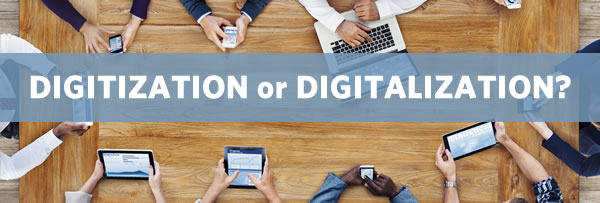
There seems to be quite some confusion regarding the usage of terms such as digitization, digitalization (two letters difference) and digital transformation. It’s less surprising than it seems. Some of these terms actually changed over time (and some, which seem new, already were used in a totally different context many years ago and then disappeared again) so not everyone uses them in the current meaning. Just for the term digitization we found about 5 different uses at the time of writing this.
A few words on the importance and evolutions of terms such as digitalization, transformation and disruption
You can guess that there will be more as digital transformation and digitalization really become hype terms, even if digital (business) transformation is very real. We also already see the same evolutions popping up regarding industrial transformation and Industry 4.0. Terms get commonly used but people forget their origins. That’s why we like to remind them which does lead to serious discussions sometimes. Yet, who wants the snake oil?
And then we even don’t tackle the differences between that buzzword digital disruption and (digital or other) business disruption, which can be due to digital technologies, the impact of people leveraging them and changing behavior but also due to societal phenomena, economical phenomena or even regulatory changes, to name a few.
Disruption in the end is a shift in power in relationships (Charlene Li)
As an example of the latter: the General Data Protection Regulation will disrupt your business or perhaps industry too. Technologies as such are rather seldom disruptive. Take mobile, which isn’t even a technology but about mobility, in the sense of ‘mobile and ability’. In other words: technologies causing behavioral changes as people love them, in turn causing disruption. People. As Charlene Li puts it in an interview on leadership, digital transformation and disruption on our site: “Transformation and disruption have something very interesting in similar: they’re both human issues, both human problems to be tackled, not technology problems”. But back to digitalization, digitization and digital transformation.
Digitalization, digitization, digital business, digital transformation: why it matters – a matter of sense
Obviously, sometimes terms do have different meanings because they are used by different people within a different context for very good reasons. And often those meanings can be totally different, given their background, which is perfectly OK.
Remember how we all talked and now and then still talk about social business in the context of hyper-connected human business, leveraging social technologies, with ‘segments’ such as social collaboration, social customer service and, of course the best known one, social media marketing? Well, as you might know social business also means something else. Just look up what Professor Muhammad Yunus means when he speaks about social business. And he was first, long before social business in the context we use it came around. For Yunus social is really social, it has close to nothing to do with social as in social technologies.
Fortunately we don’t have the same issues of extremely different meanings when it boils down to digitization, digitalization and digital transformation but still, confusion does reign and far from everyone agrees. So let’s take a look at each one of them. Why does it matter? Well, although some of these terms are used interchangeably and that really doesn’t harm anyone, it’s good to know what we talk about if we use one of those terms.
It makes things clearer, makes you look better when having to present something to someone and you use the terms correctly and, maybe most importantly, it doesn’t cause confusion in times when everyone use these terms for different purposes, which makes them meaningless in the end. Words are important.
What is the difference between digitization and digitalization?
Digitization is a term we’ve been all using for ages. Yet, at the same time, as the example in the beginning shows, not always in the right context, at least in our view.
Here is another one, by way of example. Someone wanted to digitize his workforce. Sounds scary, doesn’t it? It creates this image of a huge machine that is brought in to turn all workers into bits and bytes instead of atoms (more about the bits versus atoms idea by the way in our post on the information age).
What is digitization? The first definition
Digitization is used in many contexts it is very often confounded and/or interchangeably used with digitALization. So, what is digitization?
Digitization is used in several meanings as said but for us it has two meanings which are closely related with each other.
For starters, digitization is creating a digital (bits and bytes) version of analog/physical things such as paper documents, microfilm images, photographs, sounds and more. As the people of the Caribbean Community Climate Change Centre tweeted us, there is, for instance, also the conversion of analog audio and video production to digital formats to which we refer as, indeed, digitization.
So, it’s simply converting and/or representing something non-digital (other examples include signals, health records, location data, identity cards, etc.) into a digital format which then can be used by a computing system for numerous possible reasons.
Digitizing doesn’t mean replacing the original document, image, sound, etc. Sometimes it gets destroyed (after having digitized a paper document you can destroy it or keep it, depending on, for instance, legal requirements), sometimes it disappears anyway (if we capture the sound and images in the form of video of your presentation at an event, the digital format continues to exist while your voice and physical presentation during that presentation are gone forever) and sometimes it is transformed but that’s not that much about digitization in the strictest sense (if you take a picture of a building you have a digitally born representation of the building but the building is not digitized or you might have an analog picture which you scan so it is digitized).
Digitization defined in the context of processes
In the context of ‘physical information carriers’, such as paper documents or analog, printed images, we mainly digitize by using document scanners in business (you can also, for instance, scan or simply take a picture with your mobile).
These document scanners create a digital representation (document imaging) of a scanned document, a photograph, etc. But it doesn’t stop with document imaging in most cases. After all, why scan a document if you don’t use the data it contains (except for archiving or, as many companies still do, for real capture after the scan)? Normally and in most business cases it’s far more important that the data which capture software can retrieve from the scanned image, by using all sorts of intelligent and less intelligent capture technologies, are extracted in a digital form and leveraged to feed a workflow, a business process, a system, whatever is needed to achieve an outcome.
And that brings us to the second meaning of digitization. In business we speak about digitization from the perspective of processes too.
In a sense it often becomes a synonym of automation here. That second meaning comes from the fact that in a business context we digitize documents for a reason, in practice a chain of events and actions, as explained (workflows, processes,…). So, if you use digital data, extracted from physical carriers, to automate business processes and workflows, we speak about digitization as well.
When you hear people say “we have digitized”, most of the time they mean “we have moved from paper to digital data and from manual processes ,which were about dealing with paper, to digital and automated workflows and processes.”
In conclusion: digitization is digitization. Period. Digitization is the automation of existing manual and paper-based processes, enabled by the digitization of information; from an analog to a digital format.
You’ll notice that today digitization is indeed mainly used in a context of document capture and scanning, and in a context of digitizing business processes. Admittedly, for some digitization is more than what we just described. Pwc, for instance, talks about ‘the digitization megatrend’, speaking about a digitized world. And at Cisco they seem to refer to digitization as “the connection of people, process, data and things to provide intelligence and actionable insights enabling business outcomes”. Fair enough, it’s a free world, but if you ever read another post on this site and see the term digitization, that’s not what we mean! It’s not easy indeed.
What is digitalization?
The second term is digitalization. Often used interchangeably with digitization as mentioned (and with digital transformation too), digitalization is really something else.
And here we have three definitions, or better contexts in which the term is used.
In business, digitalization most often refers to enabling, improving and/or transforming business operations and/or business functions and/or business models/processes and/or activities, by leveraging digital technologies and a broader use and context of digitized data, turned into intelligence and actionable knowledge (remember DIKW?), with a specific benefit in mind.
It requires digitization of information but it means more and at the very center of it is data, nowadays lots of data and big data. While digitization is more about systems of record and, increasingly systems of engagement, digitalization is about systems of engagement and systems of insight, leveraging digitized data and processes.
It’s in this meaning and information-rich context that we mainly use it.
A second aspect that is often mentioned is the digitalization of a specific ‘environment’ or area of business.
Take the digital workplace. Often you strive towards a minimum of paper. But a digital workplace is about other things as well. It also means that your workforce works differently, using digital tools such as the mobile devices and technologies that make them mobile and/or using social collaboration and unified communication platforms, which are digital systems, enabling them to work in a more “digital way”. This, in turn, creates new opportunities to engage differently. And it requires more than just digitized data.
Digitalizing your business leads to digital business. The list of what you can digitalize (supply chains, leading to digital supply chains, etc.) is long.
In general, digitalization is seen as the road of moving towards digital business and digital transformation, as well as the creation of new – digital – revenue streams and offerings while doing so. And that requires change. This is why many people interchangeably use digitalization and digital transformation (so do we often).
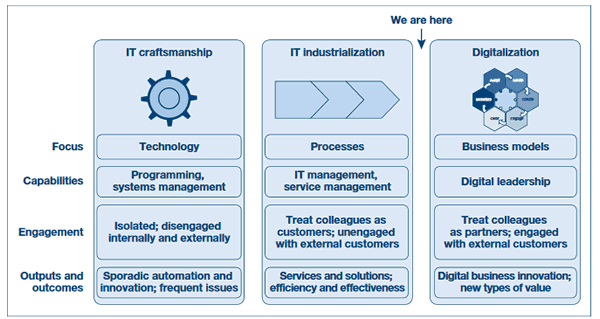
A third meaning of digitalization goes beyond business and refers to the ongoing adoption of digital technologies across all possible societal and human activities.
Think about, for instance, the increasingly digital customer, the rise of digital healthcare, the growing digitalization of government, of marketing, of customer service, etc. In other words: more digital (in various possible areas). We know; confusing.
What is the difference between digitalization and digital transformation?
If digitalization is also about changing business operations, business models and even revenue streams and new business opportunities, then what is the difference between digital transformation and digitalization?
As just mentioned, de facto many people use digitalization and digital transformation interchangeably but it is not 200% correct to do so (we do it as well, however).
Digital transformation, as we use it today, is broader than digitalization as a way to move to digital business. It requires far more bridges to be built in an encompassing digital transformation strategy. The reason why we say ‘as we use it today’ is that originally digital transformation was used to describe the transformation of, for instance, paper into digital information. Wait, wasn’t that digitization? Indeed! You see where the confusions come from.
Today, some people, mainly active in the document and scanning business, still use the term digital transformation while they mean the digitization of documents AND of processes.
However, the vast majority, defines digital transformation as an enterprise-wide phenomenon. But some only look at specific aspects, thus often creating silos or having a view that’s too technological or too much focused on one aspect of business, you name it.
Digitalization leads to digital business, digital transformation requires digital business and digitization
If you look up the definition of digital transformation on Google you’ll read “Digital transformation is the profound and accelerating transformation of business activities, processes, competencies and models to fully leverage the changes and opportunities of digital technologies and their impact across society in a strategic and prioritized way.”
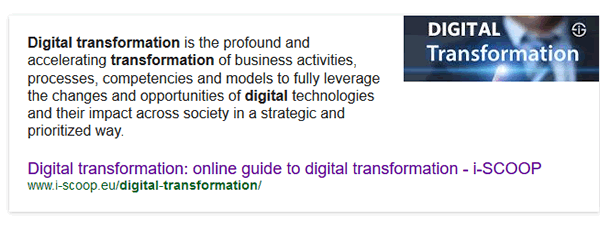
It is long and if you read further there is even more. We apologize for that because it’s how we start our digital transformation page (don’t ask how we got in that definition; it’s been close to a year no and there is no trick, it can change anytime).
Anyway, that definition, which is continued on our digital transformation page, builds upon the work of the MIT Center for Digital Business and Capgemini Consulting.
In the graphic below from their digital transformation page, you’ll notice that digital business is an aspect of digital transformation but that digital transformation is more. And for us it’s even about still more as you can read on that mentioned digital transformation page and elsewhere across this site.
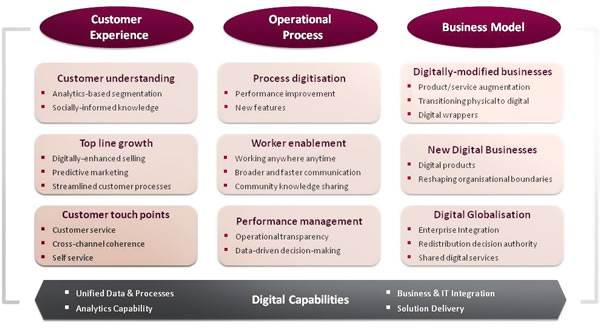
Digital transformation encompasses all aspects of business, regardless of whether it concerns a digital business or not, in times when the acceleration of technology adoption and of change leads to entirely new market, customer and business (people, capabilities, processes, models,…) realities, opportunities and challenges, ultimately leading to a new economy (what IDC calls the DX economy).
Digitalization on the other hand, is what leads to digital busines.
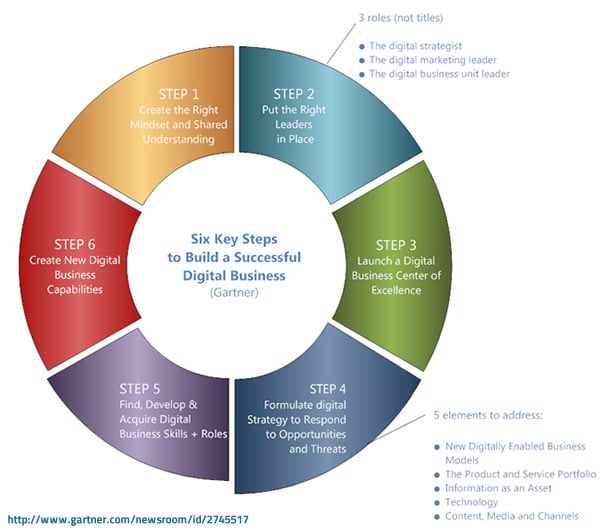
Still with us? If you interchangeably talk about digitalization, digital business and digital transformation we understand. We do to. However, we try to differ, even if we’re sure you’ll find mistakes on this site as well.
Summarizing you can say that digital transformation requires digitalization ‘en route’ to digital business (capabilities) and requires digitization, since the glue and a core business asset of digital transformation (and of digitalization) is obviously (digital) data, leading to information, knowledge, intelligence, action and business model changes.
Digitization in one sentence? Digitization is the transformation from analog to digital or digital representation of a physical item with the goal to digitize and automate processes or workflows.
Top image: Shutterstock – Copyright: Rawpixel.com – All other images are the property of their respective mentioned owners.

